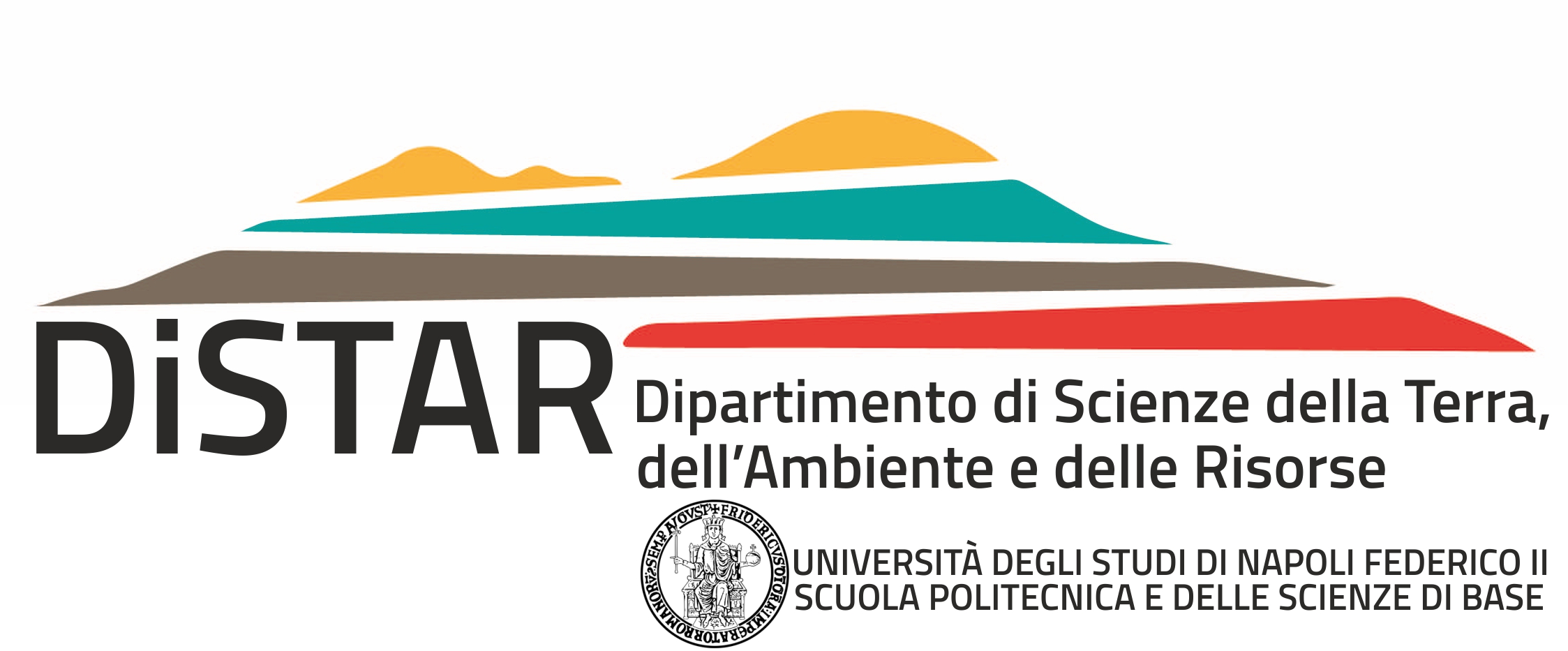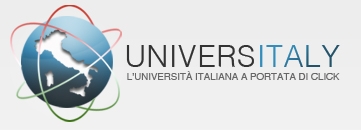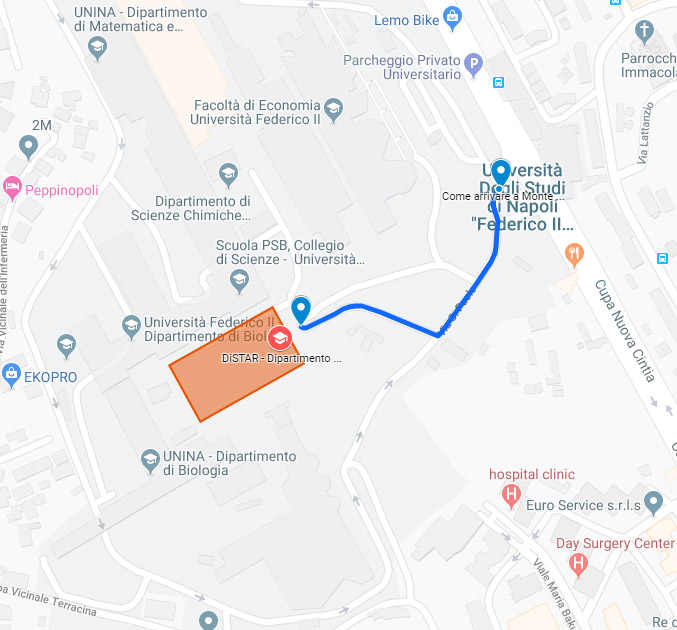Applied Mineralogy
Staff
Prof. P. Cappelletti, Prof. A. Langella, Prof. V. Morra, Prof. G. Balassone, Dr. A. Colella, Dr. S.F Graziano, Dr. F. Izzo, Dr. C. Rispoli, Dr. Claudia Di Benedetto, Dr. R. de Gennaro
Unstructured Collaborators:
G. Montesano (Research Fellow, UniCH)
PhD Students:
M. Mercurio (PhD, DiSTAR - XL cycle), S. Spadavecchia (National PhD Program HS - XXXIX cycle)
The Research Unit specializes in the enhancement of Italian mineral resources, with particular attention to minerals and rocks of industrial interest. Within this field, several research lines are present, including:
- Study and characterization of zeolitites for applications in technologically relevant sectors (pharmaceutical industry, environmental sector);
- Study and mineralogical characterization of geomaterials (both natural and originating from industrial processes—waste and secondary raw materials) for technological uses (light aggregates, ceramics, broadly defined);
- Study and characterization of geomaterials with pozzolanic activity (pozzolans sensu stricto, volcanic materials from various districts, both Italian and international);
- Study and characterization of macro- and mesoporous stone materials and their degradation products in the built environment.
Main Collaborations
- Dr. Marie D. Jackson, Utah University, USA
- Prof. D. Bish, Chemistry Department, Indiana University Bloomington (USA)
- Prof. Magnus T. Gudmundsson, University of Iceland, Iceland
- Dr. Tobias B. Wiesenberger, Mohammed VI Polytechnic University, Morocco
- Dr. A. Dakovic, ITMNS, Belgrade, Serbia
- Prof. M. Mercurio and Prof. F. De Nicola, Department of Science and Technology, University of Sannio (Benevento)
- Prof. D. Gatta, Department of Earth Sciences, University of Milan
- Prof. S. Columbu, Department of Chemical and Geological Sciences, University of Cagliari
- Prof. D. Caputo and Prof. Barbara Liguori, Department of Chemical, Materials, and Industrial Production Engineering, Federico II University
- Prof. M. Dondi and Dr. C. Zanelli, Institute of Science and Technology of Ceramic Materials, CNR-ISTEC
- Prof. D. Baldantoni, Department of Chemistry and Biology "Adolfo Zambelli," University of Salerno
Other Partners
- Italiana Zeoliti, Pigneto (MO)
- Inza (International Natural Zeolites Association)
- CNR-ISTEC, Faenza
- CBC Minerali, Vignola (MO)
- International Marble Institute (MI), Eng. P. Marone
- Marmomacchine (MI), Eng. P. Marone
- RSK (Responsible, Sustainable, Knowledgeable) Group, UK
- ZEOCEL Italia, Pisa
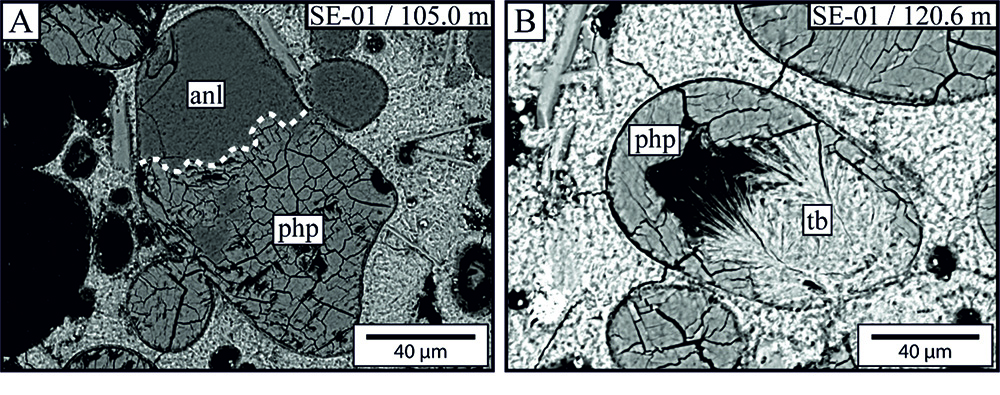 1) Backscattered electron showing A) the partial alteration of analcime to phillipsite in a lapillus vesicle and B) the growth of tobermorite in a vesicle with phillipsite surface texture. Da Prouse et al., 2020 Alteration progress within the Surtsey hydrothermal system, SW Iceland – A time-lapse petrographic study of cores drilled in 1979 and 2017 Journal of Volcanology and Geothermal Research 392 (2020) 106754
1) Backscattered electron showing A) the partial alteration of analcime to phillipsite in a lapillus vesicle and B) the growth of tobermorite in a vesicle with phillipsite surface texture. Da Prouse et al., 2020 Alteration progress within the Surtsey hydrothermal system, SW Iceland – A time-lapse petrographic study of cores drilled in 1979 and 2017 Journal of Volcanology and Geothermal Research 392 (2020) 106754
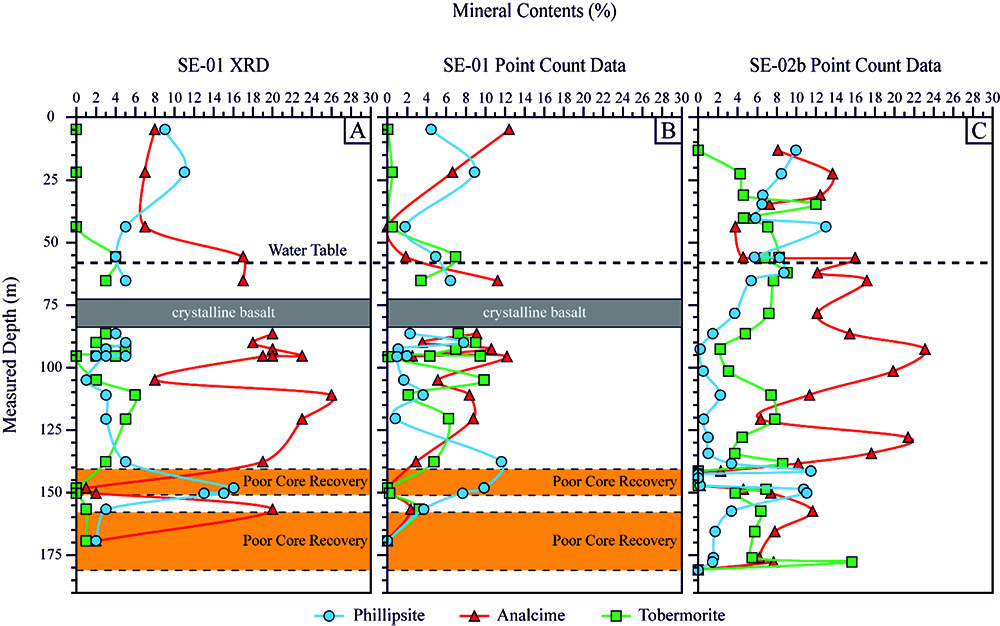 2) Relative distributions of phillipsite, analcime and tobermorite in the Surtsey drill cores based on A) x-ray diffraction (wt.%) and B) & C) point counts (vol.%). Overall, analcime content has increased at nearly all depths, although it varies from sample to sample. Phillipsite content has noticeably increased only in certain samples above 65.4 m depth. SE-02b contains slightly less phillipsite than SE-01 in the depth interval between 65.4 and 138.4 m. The top and bottom of the poorly altered zones situated between about 138-150 m show phillipsite, but no increase in analcime and tobermorite with depth or time. Tobermorite has mostly increased above water level and towards the bottom of the drill hole, but has decreased overall in the zone of maximum temperature. Due to incomplete core recovery in SE-01 only cutting samples were available at some depth intervals within the poorly consolidated zone and towards the bottom of the drill core. Da Prouse et al., 2020 Alteration progress within the Surtsey hydrothermal system, SW Iceland – A time-lapse petrographic study of cores drilled in 1979 and 2017 Journal of Volcanology and Geothermal Research 392 (2020) 106754
2) Relative distributions of phillipsite, analcime and tobermorite in the Surtsey drill cores based on A) x-ray diffraction (wt.%) and B) & C) point counts (vol.%). Overall, analcime content has increased at nearly all depths, although it varies from sample to sample. Phillipsite content has noticeably increased only in certain samples above 65.4 m depth. SE-02b contains slightly less phillipsite than SE-01 in the depth interval between 65.4 and 138.4 m. The top and bottom of the poorly altered zones situated between about 138-150 m show phillipsite, but no increase in analcime and tobermorite with depth or time. Tobermorite has mostly increased above water level and towards the bottom of the drill hole, but has decreased overall in the zone of maximum temperature. Due to incomplete core recovery in SE-01 only cutting samples were available at some depth intervals within the poorly consolidated zone and towards the bottom of the drill core. Da Prouse et al., 2020 Alteration progress within the Surtsey hydrothermal system, SW Iceland – A time-lapse petrographic study of cores drilled in 1979 and 2017 Journal of Volcanology and Geothermal Research 392 (2020) 106754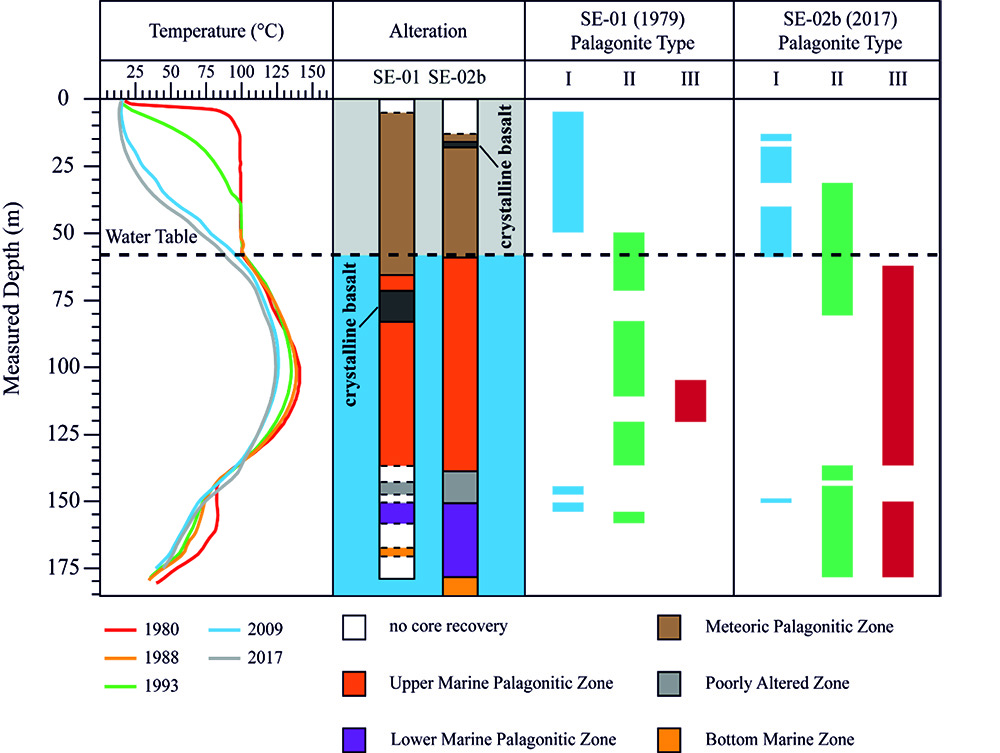 3) Integrated log displaying the relationship between temperature, alteration progress and maturation of palagonitic processes in altered glass determined through petrographic investigations of thin sections in the archived 1979 SE-01drill core and the 2017 SE-02b drill core samples. Da Prouse et al., 2020 Alteration progress within the Surtsey hydrothermal system, SW Iceland – A time-lapse petrographic study of cores drilled in 1979 and 2017 Journal of Volcanology and Geothermal Research 392 (2020) 106754
3) Integrated log displaying the relationship between temperature, alteration progress and maturation of palagonitic processes in altered glass determined through petrographic investigations of thin sections in the archived 1979 SE-01drill core and the 2017 SE-02b drill core samples. Da Prouse et al., 2020 Alteration progress within the Surtsey hydrothermal system, SW Iceland – A time-lapse petrographic study of cores drilled in 1979 and 2017 Journal of Volcanology and Geothermal Research 392 (2020) 106754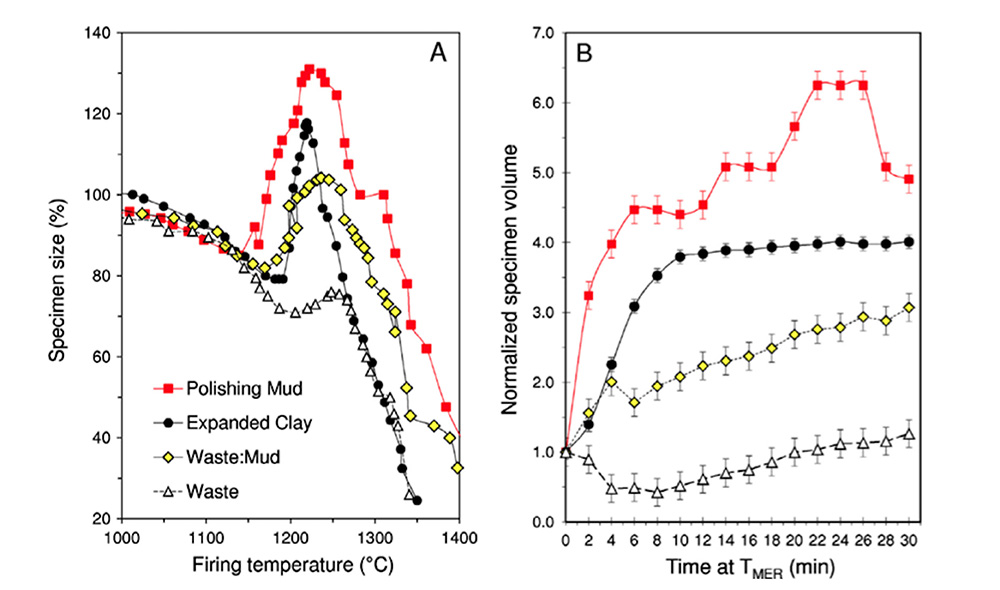 4) Examples of the behavior of different materials during hot-stage microscope runs at constant thermal rate (A) and in isothermal conditions (B). Lightweight aggregates from waste materials: Reappraisal of expansion behavior and prediction schemes for bloating Construction and Building Materials 127 (2016) 394–409
4) Examples of the behavior of different materials during hot-stage microscope runs at constant thermal rate (A) and in isothermal conditions (B). Lightweight aggregates from waste materials: Reappraisal of expansion behavior and prediction schemes for bloating Construction and Building Materials 127 (2016) 394–409 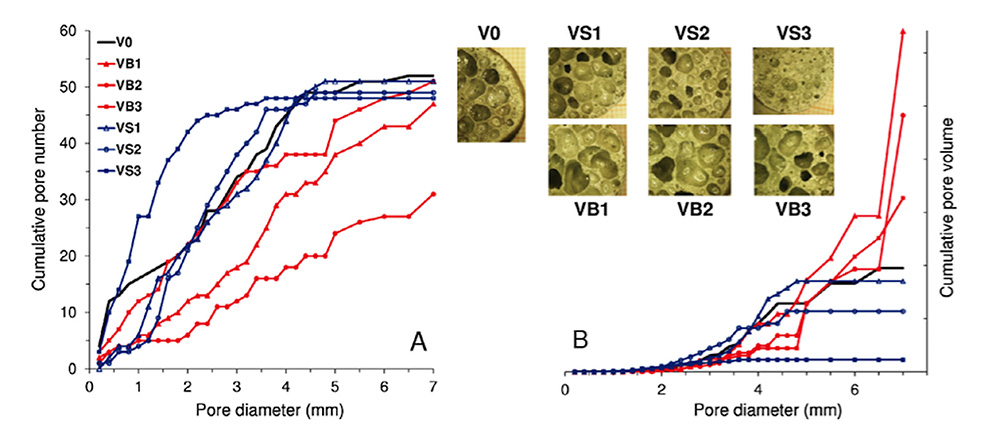 5) Microstructure and pore distribution of LWA: as cumulative number (A), cumulative volume (B). Lightweight aggregates from waste materials: Reappraisal of expansion behavior and prediction schemes for bloating Construction and Building Materials 127 (2016) 394–409
5) Microstructure and pore distribution of LWA: as cumulative number (A), cumulative volume (B). Lightweight aggregates from waste materials: Reappraisal of expansion behavior and prediction schemes for bloating Construction and Building Materials 127 (2016) 394–409 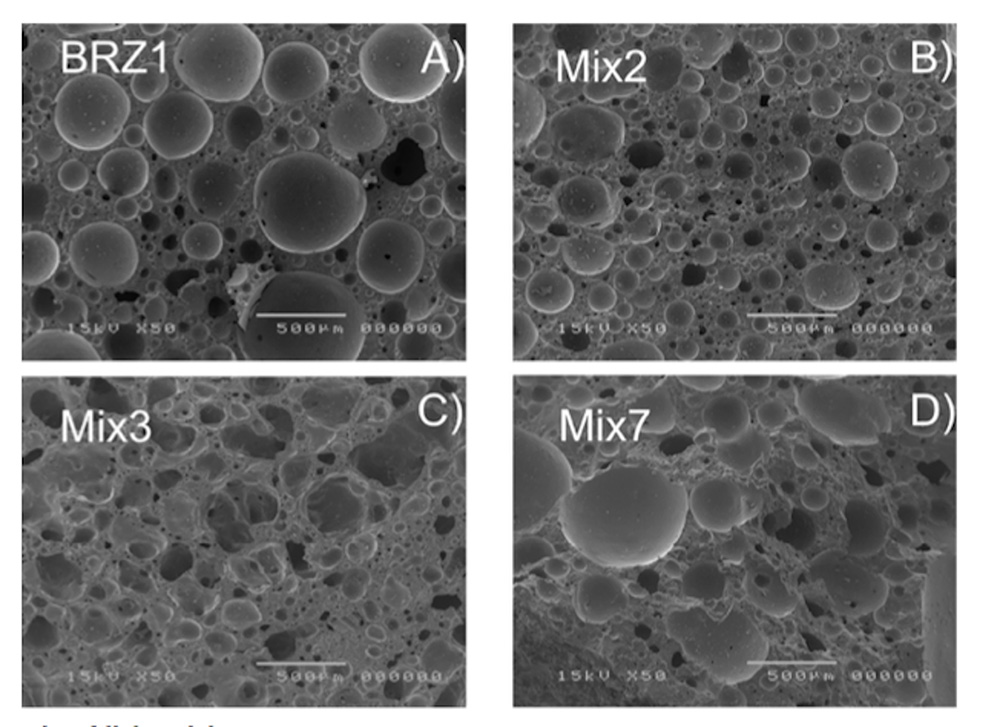 6) SEM micrographs of lightweight aggregates. Structural Concretes with Waste-Based Lightweight Aggregates: From Landfill to Engineered Materials Environ. Sci. Technol. 2009, 43, 7123–7129
6) SEM micrographs of lightweight aggregates. Structural Concretes with Waste-Based Lightweight Aggregates: From Landfill to Engineered Materials Environ. Sci. Technol. 2009, 43, 7123–7129 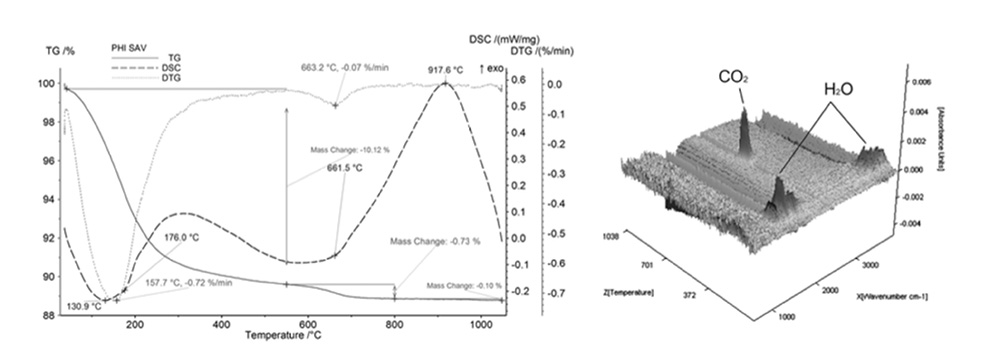 7) Thermal properties of starting materials by TG/DSC coupled with FTIR-EGA. Surface-modi ed phillipsite-rich tuff from the Campania region (southern Italy) as a promising drug carrier: An ibuprofen sodium salt trial American Mineralogist, Volume 103, pages 700–710, 2018
7) Thermal properties of starting materials by TG/DSC coupled with FTIR-EGA. Surface-modi ed phillipsite-rich tuff from the Campania region (southern Italy) as a promising drug carrier: An ibuprofen sodium salt trial American Mineralogist, Volume 103, pages 700–710, 2018 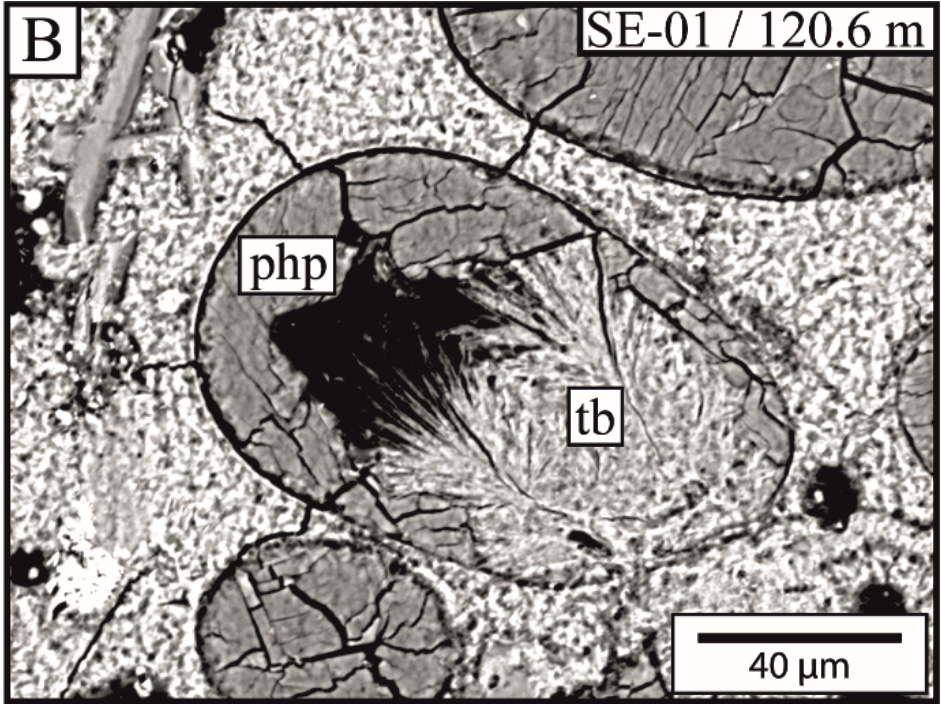 8) Physico-chemical and thermal properties of IBU. Surface-modi ed phillipsite-rich tuff from the Campania region (southern Italy) as a promising drug carrier: An ibuprofen sodium salt trial American Mineralogist, Volume 103, pages 700–710, 2018
8) Physico-chemical and thermal properties of IBU. Surface-modi ed phillipsite-rich tuff from the Campania region (southern Italy) as a promising drug carrier: An ibuprofen sodium salt trial American Mineralogist, Volume 103, pages 700–710, 2018 